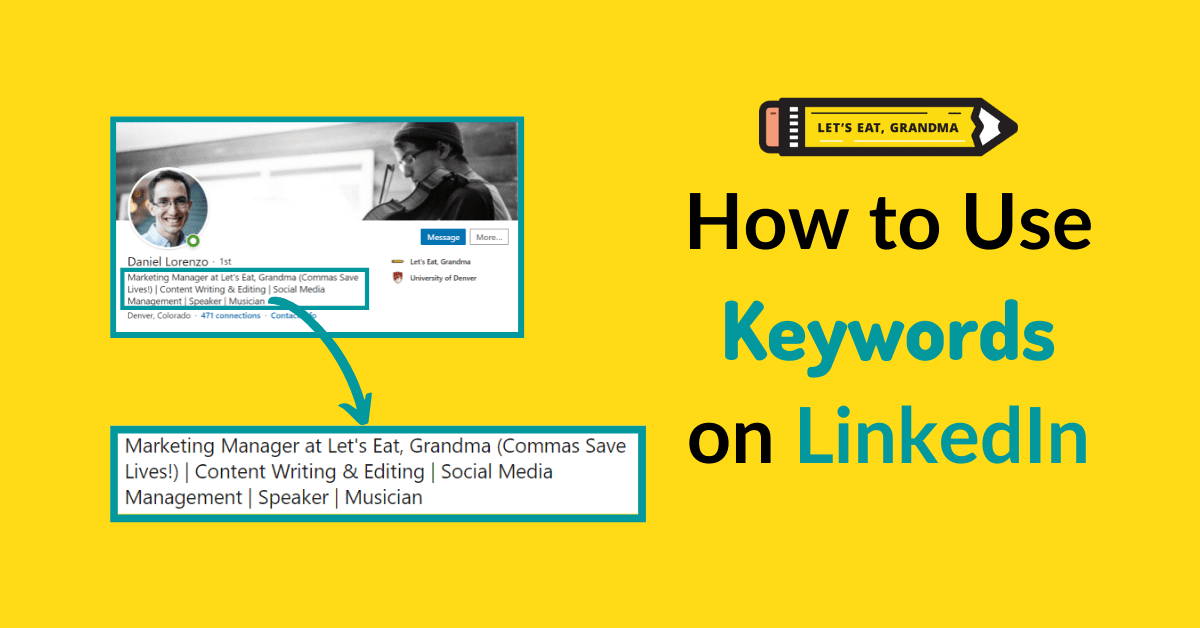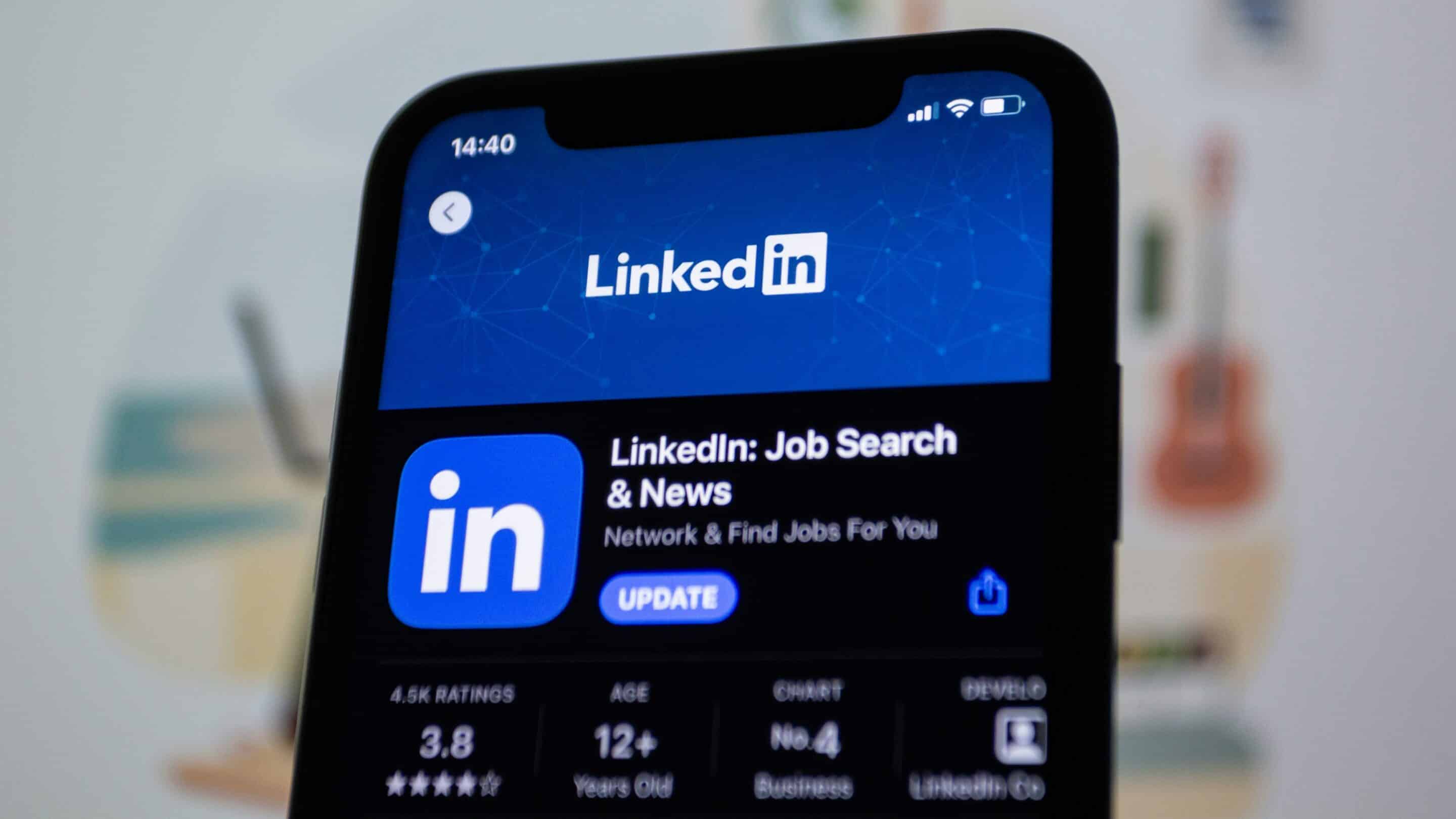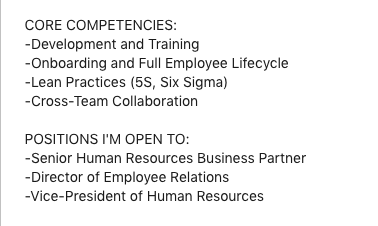Are You Using the Top Keywords for Your LinkedIn in 2024?

If you’re not using LinkedIn keywords for your job search, you need to. Learn how to integrate the top keywords for LinkedIn in your profile.
Editor’s note: This post was originally published in 2020; it has been updated for accuracy and comprehensiveness.
By: Daniel Lorenzo | Contributor for Let’s Eat, Grandma
You need to be using LinkedIn for your job search. Full stop.
According to Zippia, 87% of company recruiters think LinkedIn is the most effective resource for finding candidates. Whether you’re in engineering, marketing, or HR, using the top keywords for LinkedIn is crucial to attracting recruiters to your profile. If you don’t, you’ll be missing out on an entire network of potential job offers.
So what are the most searched keywords on LinkedIn? How do you find them, and how do you include them in your profile?
How are LinkedIn keywords different from resume keywords?
First, let’s discuss how keywords for your LinkedIn profile are different from keywords on your resume.
The same basic concept applies to both; keywords are common phrases that are searched by recruiters to find profiles/resumes of qualified candidates.
Ready for more job search help?
Sign up for a free Senior Writer Resume Critique to see what's holding you back from landing interviews. One of our top professional resume writers will give you personalized feedback on the top 3 items you can improve based on our expert practices!

Photo by Shutter Speed on Unsplash
Recruiters search for these in resumes using an applicant tracking system (ATS), and in LinkedIn profiles by using the LinkedIn Recruiter platform.
Not surprisingly, the top keywords for LinkedIn are all generally keywords that will be included on your resume, too.
The difference is in how these keywords are used. While resume keywords are tailored to each job description to pass through an ATS for one specific position you apply to, LinkedIn keywords can apply to multiple positions to make you appear in the searches of multiple recruiters.
Top keywords for your LinkedIn profile
Just like in an ATS, recruiters use the LinkedIn Recruiter platform to search for candidates by position titles, location, and skills.
It’s also important to note that they can search for candidates that have certain combinations of skills. So, make sure to cover your bases by using multiple spellings and synonyms of keywords!
Here’s a list of top keywords for your LinkedIn profile, based on what recruiters search for:
1. Position titles
Specific job titles are among the most searched keywords on LinkedIn. Recruiters aren’t just going to search for a “Tech Industry Leader.” They’re searching for “Senior Software Engineer,” “UX Design Associate,” or “Mobile Application Developer.”
Make sure not only your current job title but the exact titles of prospective jobs you’re looking at are present in your LinkedIn profile.
2. Location
Similarly, don’t just list your current location on your profile (though you should absolutely do that.) If you’re looking to relocate, be sure to mention the particular cities, states, and regions you’re interested in.
3. Skills & certifications
Searching for skills and certifications is a surefire way for recruiters to find profiles that fit the mold of their ideal candidate.
To ensure you appear in recruiter searches, integrate names of hard skills, such as specific software and methodologies (Salesforce, Agile Methodologies, Kanban) and soft skills (cross-functional leadership, communication, prioritization) in your skills section, About section, and throughout your profile.
Likewise, be sure to include important certifications you hold, again in the Certifications section, About section, and even your Skills section. Many job descriptions will call only for candidates who have a PMP, SHRM, or similar certification, so you better believe recruiters will search for those.
In all of these, use industry-standard language. If you’re a Certified Scrum Master, say exactly that instead of something like “Scrum expert.” Include the full names of certifications as well as the acronyms.
So where does one determine what the top keywords for their LinkedIn profile should be? Plain and simple: look at job descriptions.
Just like on your resume, one-size-fits-all doesn’t work – you need to be strategic about which jobs you’re applying to and pull keywords from those postings.
Not sure what you’re looking for yet, or open to multiple positions? Pick out a few job titles and try to include general keywords from those as a start.

Photo by LinkedIn Sales Solutions on Unsplash
Where and how to integrate keywords
Now that you know what to include, here are the best places to naturally integrate these top keywords in your LinkedIn profile.
1. Headline
Your headline is the first thing a recruiter will see when they look at your profile. Why waste that valuable space with just your current position title and company? A great LinkedIn headline includes dynamic, relevant keywords to catch the recruiter’s eye and make them want to see more of your profile.
Here are some good examples of how to do this:


Pro-tip: The maximum character count in the last name field is large, giving you plenty of room to sneak your certification, MBA, or other advanced degree in your name field. Just put it after your last name, like this:
John Smith, PMP
2. About section
Your About section is the cornerstone of your LinkedIn profile. It’s also an easy place to include keywords.
When filling out this section with your professional philosophy and examples of your biggest accomplishments, specify how you did all of them. This is where you can mention those skills and certifications that we discussed above.
If you have the room, we even recommend getting bold and listing a whole category of 6-8 keywords under a section labeled Core Competencies or Key Skills.
Plus, if you’re not currently employed, you can even list your desired position titles as a list like this to include targeted keywords for all of them!

Again, keep the content relevant – don’t go crazy and keyword stuff here. This section still has to be a readable narrative that tells the story of how you’ve used your skillset to succeed in your career.
3. Experience section
Too many LinkedIn users neglect filling out their Experience section as they would on a resume. In fact, this section should be even more full than on your resume!
There’s no limit to how many experiences you can include here, so feel free to go back to older positions if you’ll be able to include strong keywords in them.
You can fit in some great keywords here by optimizing your position titles. While you should not change or doctor your official job titles (i.e., calling yourself a “marketing director” when you were an “account manager”), you can add the main areas you were in charge of if they’re keywords.
For example, those aiming for marketing keywords for their LinkedIn could do this:

Make sure to optimize the language in these bullet points to include important and relevant skills and certifications. You can also add your top 5 skills from your skills section that you used in each role.
Make sure to include the locations, too, especially if you’re applying in the same city.
Don’t forget the Career Break feature – this can allow you to include keywords for skills you used or obtained during times you were between jobs.

Photo by Vitaly Gariev on Unsplash
4. Skills section
This one is too easy. You have a whopping 100 slots available to fill out in this section. There’s no downside to packing it out – load it up with every skill you can lay a claim to. But don’t stretch the truth – only list a skill if in an interview you’d be able to provide an example of how you’ve used it.
Be targeted here. Prioritize the skills you’ve been finding in job descriptions, and get rid of any irrelevant skills from an older industry if you have them (at least while you’re job hunting!)
Focus on hard skills first. Recruiters aren’t going to be searching for “Attention to Detail.”
Finally, since you have so much room, be sure to include synonyms here as well. For example, if you’re trying to optimize your LinkedIn for HR keywords, don’t just settle for one skill that says “Training.” Expand that skill area in “employee development,” “onboarding,” “leadership development,” “employee retention,” and so on.
Don’t forget about endorsements in this section as well! This can add more weight to your skills.
Now you have all you need to integrate the top keywords for LinkedIn into your profile. Get ready to see more engagement from recruiters!
Ready for more job search help?
Sign up for a free Senior Writer Resume Critique to see what’s holding you back from landing interviews. One of our top professional resume writers will give you personalized feedback on the top 3 items you can improve based on our expert practices!
